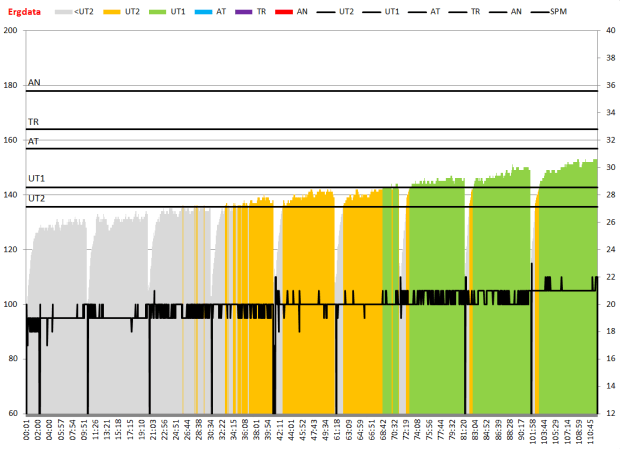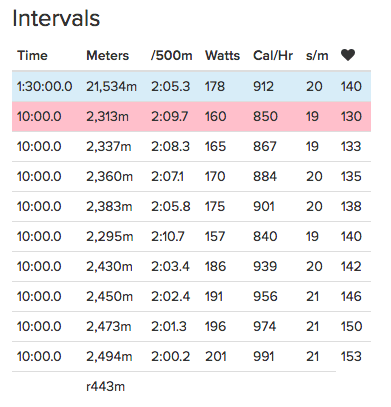Plans for any training down on the Cape this weekend were disrupted by other priorities. We had all kinds of appointments on Saturday morning, and the main mission for the day was to prepare the deck around the house for a coat of wood sealer. This took much longer than I was hoping because I vastly underestimated how much deck there was to prepare. (1400 SQ FT!) Anyway, by the time that was done, I was not in the mood to do much of anything beside hang out with my wife and drink a couple of beers.
I was thinking I could go for a row on Sunday morning, but when I woke up, it was blowing like crazy. The peak gust was 50mph (80km/h) and sustained winds were around 35mph (55km/h). I didn’t even like the thought of trying to pedal a bike into that kind of a headwind, so I decided to wait until the afternoon and just do an erg session.
But what session to do? I was planning on an early morning row in the Double with Joe on Monday morning, so I didn’t want anything too intense. And there was a fresh new box of lactate test strips that had just arrived. So, I quickly decided to do the same 10 minute step test that Sander did last week.
My protocol:
- No warmup
- 10 minute steps
- 1:30 rests
- start at 160W and increment by 5W to 200W
- Measure HR throughout and lactate at the end of each step
The purpose of the test is to help define an appropriate steady state intensity for endurance training. I suspect that it would be around 180-185W or so.
When yo put the data into a plot, it looks a bit weird. The test did not go entirely smoothly. I suspect the lactate test for 170 was contaminated with sweat, leading to a high reading. The one at 175 had to be redone due to an “E-4” (insufficient sample size). At 180, I also suspect contamination. The rest of the readings I think were good. I had my method down pretty smoothly by then and I was doing a good job cleaning my hands. I suspect that the inflection above 190W is totally legit. Based on this data, I could try to train at 190W, but I suspect that this would be a bit too intense. I did this test after a full rest day, and late in the afternoon (my best time of day). The temp was warm, but cooling down during the session.

I had plenty of time to think, and one of the things that occurred to me is that it is entirely plausible that it takes me 30 minutes to really warmup for a steady state session. Some of my best results a couple of seasons ago were when I eased into the first 20 minute session by starting at a lower power and then hitting target power for the second 20 minute piece. When I did that, I think I was able to hold higher “watts at 2.0 lactate”. I think I might make that my standard procedure over the winter.
So, 185W will be my training power for now. Next weekend, I think I will do a 90 minute session at 185W and do lactate tests every 10 minutes to see what happens. The hypothesis I am testing is that my lactate will initially rise toward 2.0, then fall back toward 1.0, hitting a trough around 40 minutes, and then start to rise again after 60 minutes.





I follow your logic. You should also have felt (at least the start of) “empty legs” at 190W and 200W, which you obviously didn’t feel at 170W and 180W. I would also put my money on your hypothesis, but real science starts when the experimentor thinks “this is funny”.
LikeLike
Interesting that you say that, because I was thinking something similar. The data was very irregular, so the scientific approach would be to repeat the same test a few times, and then design additional experiments. Since I am doing “n=1” research, it’s hard to get enough data to even estimate the uncertainty, let alone qualify the conclusions.
The limit to the approach is really
– How do I want to spend on lactate strips?
– How much do I want to perforate my finger?
– How well does it fit in with other training priorities?
From here, I think I will do the long 185W test, and the 2 speed test. Then I think I am going to be pretty obsessive about testing after each 20 minute interval during training.
I hate making such big assumptions off of crappy data.
LikeLike
Yes, that’s why in my blog I commented that “I have accepted that Lactate based training is something between black art and science”. I have accepted, but it wasn’t easy.
I think it is OK though. Do the step test, then spend on strips for measuring at 185W (I was content with just one measurement per 20 minutes) and then start monitoring your lactate after 60 minutes of steady state.
I talked to our head coach last weekend and he is a real proponent of doing steady state and he was commenting about capillaries and such – the goal of lactate testing is to have a good means to determine that you are in the optimal zone for building aerobic capacity. Lactate measurements seem to be more reliable than HR measurements, although they can be used after you calibrate your HR / power curve with your lactate curve and take into account the slow rise of HR during a steady state row, which doesn’t mean you are leaving a training zone and entering a new one.
LikeLike
The obvious pitfall here is that the “black magic” part starts to take over the scientific approach and the “coach” (you, in this case) becomes blind for what is really going on, just because his crappy data set allows him to just keep going in the direction he wants, discarding any data that are not in line with his thinking as a faulty measurement. Then you are really wasting money on strips.
Another comment: One of the things I have learned is that going by feel seems to be more in line with the measured lactate level than going by heart rate.
LikeLiked by 1 person
Good point. I think that’s the reason that I put this stuff on a public blog. I’m hoping that people who might read it will help me see if I am deluding myself.
I agree in general with the “feel” comment, but I tend to look at it as just another data point, and one that is readily affected by mood.
LikeLiked by 1 person
Personally over time I have moved away from doing the step test, mostly because I tend to find that there are always errors when I do multiple tests like this on my own, but mostly because I tend to find it’s easier and cheaper on strips to initially guess what wattage to aim for and then adjust following lactate levels I test at the end of the workout as I tend to either get very close or get it bang on using relative perceived effort and/or HR as guides to start with
LikeLiked by 1 person
Your approach is probably more logical. I have so many questions in my mind about what causes weird readings that I like to collect a lot of data. It likely results in me being more confused than when i started (and with a more damaged finger tip).
For routine sessions, when do you test? At 20 minutes, 60 minutes, when you finish, some other time?
LikeLike
I always test just at the end – initially I tested at 20 mins and then again at the end but I usually found that there wasn’t always correlation between the 20mins and the 60min so sometimes even though I was under 2mmol for 20mins that didnt necessarily mean I would be under 2mmol by the end. ve put that down to the idea that your bodys ability to process lactate has both an intensity limit and a time limit – i.e. for 60mins you might be able to do sub 2mmol at 200 watts but that doesnt mean you’d be able to do it indefinatly, at some point it would be exhausted and the lactate would rise – so for example even if I did an erg where I was at sub 2mmol at 20mins and at the end, when I I stepped up the wattage there was a good chance the 20mins would be below 2mmol but the end would be above
Since the mid tests werent correlated to the end, and since im pretty confident with my perceived effort guesstimating lactate levels, I only test at the end now to “confirm” that the whole thing was sub 2mmol and if it is low enough for me to step the wattage up again
LikeLike